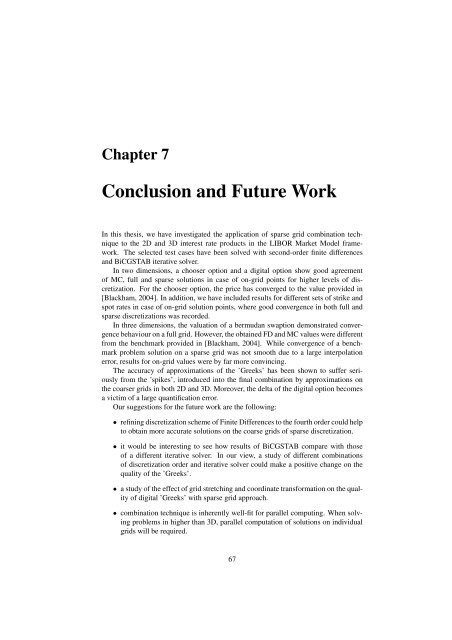sparse grid method in the libor market model. option valuation and the
sparse grid method in the libor market model. option valuation and the
sparse grid method in the libor market model. option valuation and the
You also want an ePaper? Increase the reach of your titles
YUMPU automatically turns print PDFs into web optimized ePapers that Google loves.
Chapter 7<br />
Conclusion <strong>and</strong> Future Work<br />
In this <strong>the</strong>sis, we have <strong>in</strong>vestigated <strong>the</strong> application of <strong>sparse</strong> <strong>grid</strong> comb<strong>in</strong>ation technique<br />
to <strong>the</strong> 2D <strong>and</strong> 3D <strong>in</strong>terest rate products <strong>in</strong> <strong>the</strong> LIBOR Market Model framework.<br />
The selected test cases have been solved with second-order f<strong>in</strong>ite differences<br />
<strong>and</strong> BiCGSTAB iterative solver.<br />
In two dimensions, a chooser <strong>option</strong> <strong>and</strong> a digital <strong>option</strong> show good agreement<br />
of MC, full <strong>and</strong> <strong>sparse</strong> solutions <strong>in</strong> case of on-<strong>grid</strong> po<strong>in</strong>ts for higher levels of discretization.<br />
For <strong>the</strong> chooser <strong>option</strong>, <strong>the</strong> price has converged to <strong>the</strong> value provided <strong>in</strong><br />
[Blackham, 2004]. In addition, we have <strong>in</strong>cluded results for different sets of strike <strong>and</strong><br />
spot rates <strong>in</strong> case of on-<strong>grid</strong> solution po<strong>in</strong>ts, where good convergence <strong>in</strong> both full <strong>and</strong><br />
<strong>sparse</strong> discretizations was recorded.<br />
In three dimensions, <strong>the</strong> <strong>valuation</strong> of a bermudan swaption demonstrated convergence<br />
behaviour on a full <strong>grid</strong>. However, <strong>the</strong> obta<strong>in</strong>ed FD <strong>and</strong> MC values were different<br />
from <strong>the</strong> benchmark provided <strong>in</strong> [Blackham, 2004]. While convergence of a benchmark<br />
problem solution on a <strong>sparse</strong> <strong>grid</strong> was not smooth due to a large <strong>in</strong>terpolation<br />
error, results for on-<strong>grid</strong> values were by far more conv<strong>in</strong>c<strong>in</strong>g.<br />
The accuracy of approximations of <strong>the</strong> ’Greeks’ has been shown to suffer seriously<br />
from <strong>the</strong> ’spikes’, <strong>in</strong>troduced <strong>in</strong>to <strong>the</strong> f<strong>in</strong>al comb<strong>in</strong>ation by approximations on<br />
<strong>the</strong> coarser <strong>grid</strong>s <strong>in</strong> both 2D <strong>and</strong> 3D. Moreover, <strong>the</strong> delta of <strong>the</strong> digital <strong>option</strong> becomes<br />
a victim of a large quantification error.<br />
Our suggestions for <strong>the</strong> future work are <strong>the</strong> follow<strong>in</strong>g:<br />
• ref<strong>in</strong><strong>in</strong>g discretization scheme of F<strong>in</strong>ite Differences to <strong>the</strong> fourth order could help<br />
to obta<strong>in</strong> more accurate solutions on <strong>the</strong> coarse <strong>grid</strong>s of <strong>sparse</strong> discretization.<br />
• it would be <strong>in</strong>terest<strong>in</strong>g to see how results of BiCGSTAB compare with those<br />
of a different iterative solver. In our view, a study of different comb<strong>in</strong>ations<br />
of discretization order <strong>and</strong> iterative solver could make a positive change on <strong>the</strong><br />
quality of <strong>the</strong> ’Greeks’.<br />
• a study of <strong>the</strong> effect of <strong>grid</strong> stretch<strong>in</strong>g <strong>and</strong> coord<strong>in</strong>ate transformation on <strong>the</strong> quality<br />
of digital ’Greeks’ with <strong>sparse</strong> <strong>grid</strong> approach.<br />
• comb<strong>in</strong>ation technique is <strong>in</strong>herently well-fit for parallel comput<strong>in</strong>g. When solv<strong>in</strong>g<br />
problems <strong>in</strong> higher than 3D, parallel computation of solutions on <strong>in</strong>dividual<br />
<strong>grid</strong>s will be required.<br />
67
















